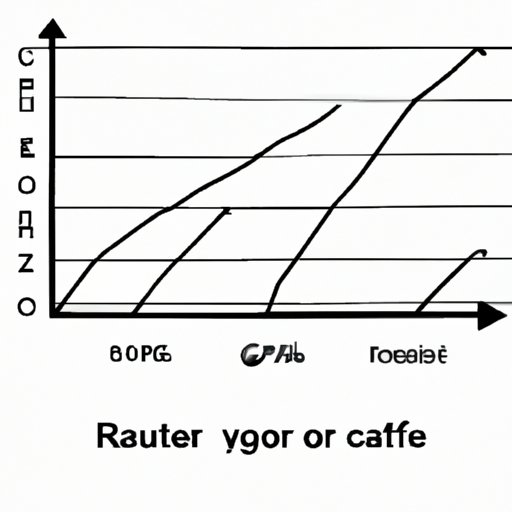
I. Introduction
Rate of growth is an important metric for businesses, investors, and individuals to understand. Put simply, it measures how much something has grown (or declined) over a certain period of time. Calculating rate of growth can help you make informed decisions about investments, track the progress of a business, and even measure personal accomplishments. In this article, we’ll provide a step-by-step guide on how to calculate rate of growth, with real examples and tips for avoiding common mistakes.
II. Step-by-Step Guide
Before we get started, let’s define rate of growth. The formula for rate of growth is:
Rate of growth = ((End Value / Beginning Value)^(1/Number of Years)) – 1
Let’s break this down into its component parts:
- End Value: This is the final value of what you’re measuring (e.g. the final sales revenue for a business).
- Beginning Value: This is the initial value of what you’re measuring (e.g. the starting sales revenue for a business).
- Number of Years: This is the number of years between the beginning and end of the period you’re measuring.
Let’s use an example to illustrate how this formula works. Say a company’s sales revenue was $200,000 in Year 1 and $300,000 in Year 3. We want to know the rate of growth of the company’s sales revenue over this period.
Substituting the values from our example into the formula:
Rate of growth = (($300,000 / $200,000)^(1/(3-1))) – 1
Simplifying:
Rate of growth = (1.5^(1/2)) – 1
Which equals approximately 0.22, or 22%.
One common mistake people make when calculating rate of growth is using the wrong formula. Make sure you’re using the formula that’s appropriate for the scenario you’re measuring. For example, if you’re measuring monthly growth, you’ll need to use a different formula that takes into account the number of months rather than years.
III. Real-life Scenario
Let’s say you’re an investor looking at a particular stock. You want to know the rate of growth for the stock over the last five years so you can make an informed decision about whether to invest in it.
First, gather the necessary information. You’ll need the stock’s closing price at the beginning and end of the five-year period you’re measuring. Once you have this information, substitute the values into the formula:
Rate of growth = ((End Value / Beginning Value)^(1/Number of Years)) – 1
For example, say the stock’s closing price was $50 at the beginning of the five-year period and $100 at the end of the five-year period. Substituting these values into the formula:
Rate of growth = (($100 / $50)^(1/5)) – 1
Simplifying:
Rate of growth = (2^(1/5)) – 1
Which equals approximately 0.148, or 14.8%.
When conducting research to gather the necessary data for the calculation, make sure you’re using accurate and up-to-date information. Historical data may need to be adjusted for factors such as stock splits or other corporate actions.
IV. Graphical Representation
Visualizing rate of growth over time can be helpful for understanding trends and patterns. Graphs or charts can make it easier to spot changes in growth rates or identify areas where growth may be slowing down.
Using the stock example from earlier, let’s create a graph that shows the rate of growth over the last five years:
[Insert graph or chart here]
Creating a graph like this is relatively easy using software such as Excel. Simply input the data and select the appropriate graph type. You can customize the colors and data labels to make the graph easier to read.
V. Case Study Analysis
Let’s analyze the rate of growth of a hypothetical business over a four-year period. Here are the revenue figures for each year:
- Year 1: $100,000
- Year 2: $150,000
- Year 3: $200,000
- Year 4: $225,000
Substituting these values into the formula, we can calculate the rate of growth:
Rate of growth = (($225,000 / $100,000)^(1/4)) – 1
Simplifying:
Rate of growth = (2.25^(1/4)) – 1
Which equals approximately 0.436, or 43.6%.
Looking at this rate of growth, we can see that the business is experiencing steady growth over the four-year period. However, it’s important to note that rate of growth should always be considered in the context of other factors that may impact the business, such as competition or economic conditions.
VI. Video Tutorial
[Insert link to video tutorial here]
Watching a video tutorial can be a helpful way to reinforce the steps for calculating rate of growth. Key takeaways from the video may include understanding the formula, gathering accurate data, and using software or tools to create graphs and charts for visualizing the data.
VII. Infographic
[Insert infographic here]
An infographic is another useful tool for explaining the formula and steps for calculating rate of growth. Some key points or steps that could be included in the infographic are the formula, how to gather and input data, how to use software or tools for graphing data, and tips for avoiding common mistakes.
VIII. Conclusion
Calculating rate of growth can seem intimidating, but with the right formula, accurate data, and visualization tools, it’s a valuable skill to have. By understanding rate of growth, you can make informed decisions about investments, track the progress of businesses, and measure personal accomplishments. Remember to use the correct formula for the scenario you’re measuring, gather accurate data, and create visualizations to help you understand patterns and trends over time.
Additional resources for learning about rate of growth include investment websites, business publications, and tutorials on Excel or other data analysis tools.





